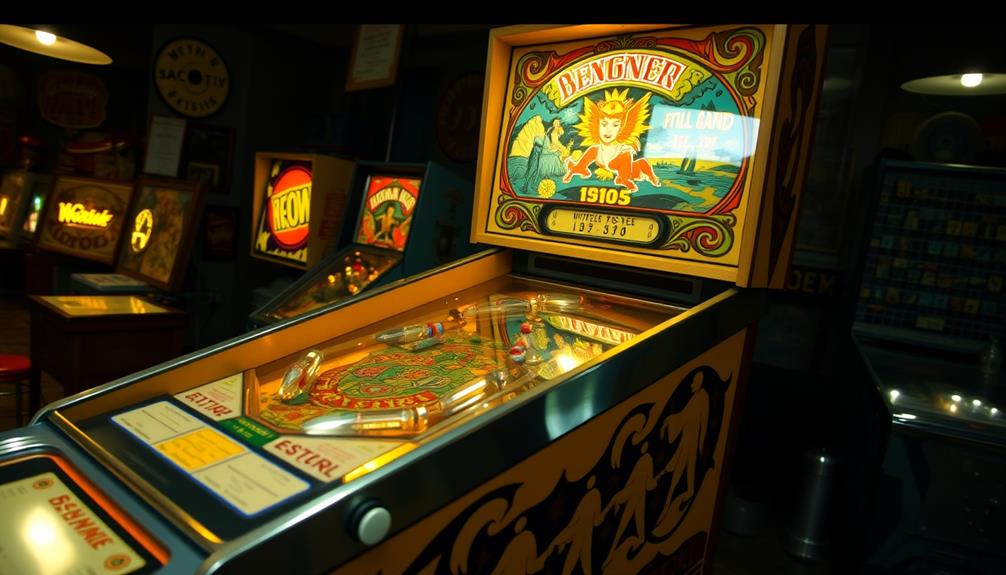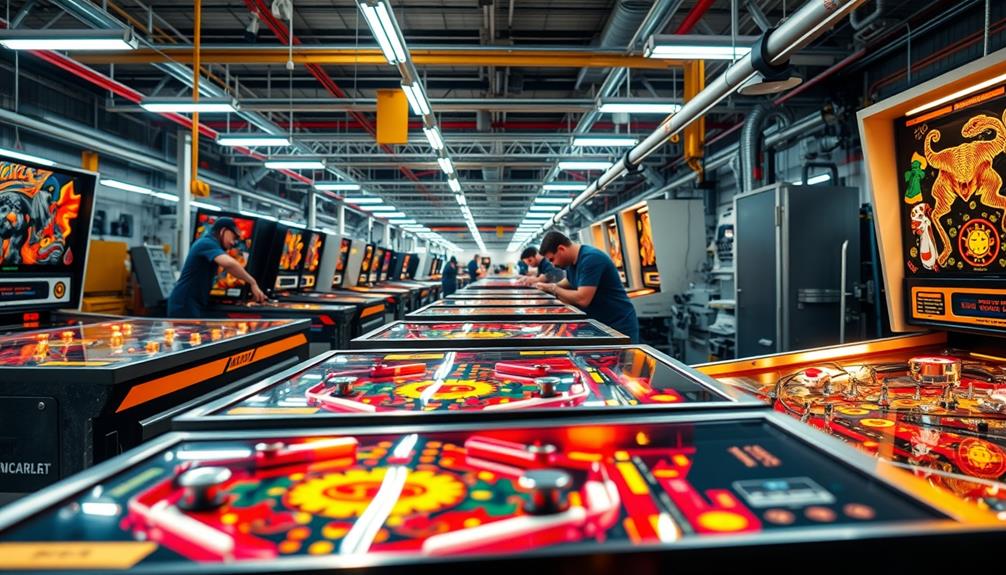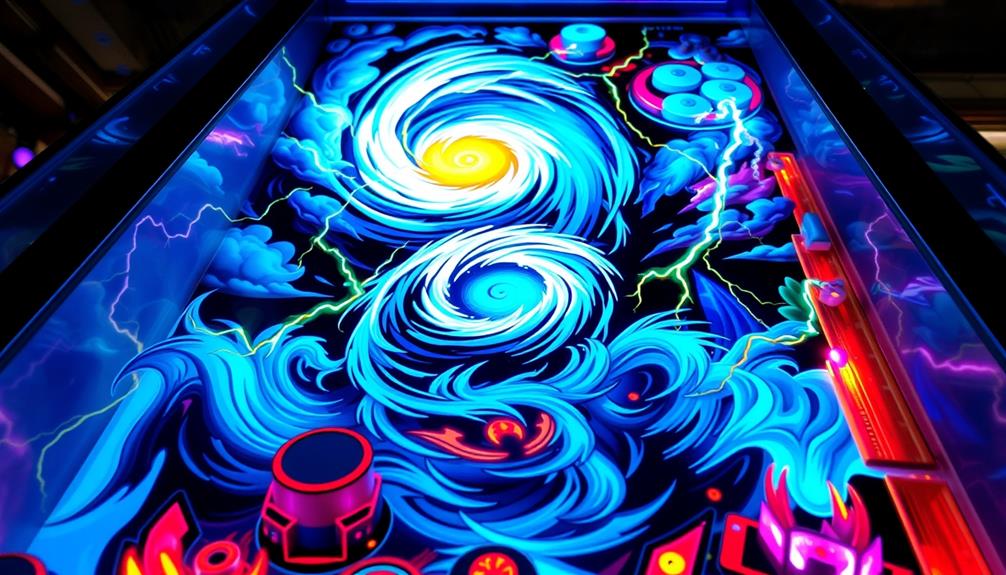Electromechanical (EM) pinball machines combine mechanical parts like gears, relays, and switches to create gameplay, while solid-state machines use electronic circuit boards, LEDs, and microprocessors for more advanced features. EM games offer straightforward, tactile play but need more mechanical maintenance. Solid-state models deliver richer gameplay, diverse visuals, and multimedia effects but can be more complex to repair. To understand how these differences affect gameplay, maintenance, and collectibility, explore further.
Key Takeaways
- EM pinball machines rely on mechanical relays and switches, while solid-state models use circuit boards and microprocessors.
- EM machines are generally more durable and easier to maintain mechanically; solid-state systems offer advanced features and customization.
- Solid-state pinballs support complex rules, multi-ball modes, and multimedia effects, unlike the simpler mechanical gameplay of EM machines.
- Visual and sound effects in solid-state machines are vibrant LED lights and layered audio, whereas EM machines have basic lighting and sounds.
- EM pinball machines are often rarer and more collectible today, with solid-state models offering more modern gameplay and digital enhancements.
Historical Development and Timeline

The evolution of pinball technology reflects a fascinating interplay between traditional electromagnetism (EM) designs and modern solid-state systems. Originally, pinball machines emerged from arcade origins in the early 20th century, evolving from simple mechanical games. As technology advanced, designers incorporated electromagnets and relays, creating electro-mechanical machines that added scoring and sound features. The technological evolution peaked in the mid-20th century with the introduction of electronic components, leading to solid-state pinball machines. These newer systems replaced mechanical parts with circuit boards, microprocessors, and digital displays, offering more complex gameplay and reliable operation. This timeline highlights how pinball’s core mechanics transitioned from purely electro-mechanical devices to sophisticated electronic systems, reflecting broader shifts in technology and arcade entertainment. Additionally, the shift to solid-state systems allowed for greater programmability and customization of game features, revolutionizing the player experience.
Core Mechanical Components and Electronics
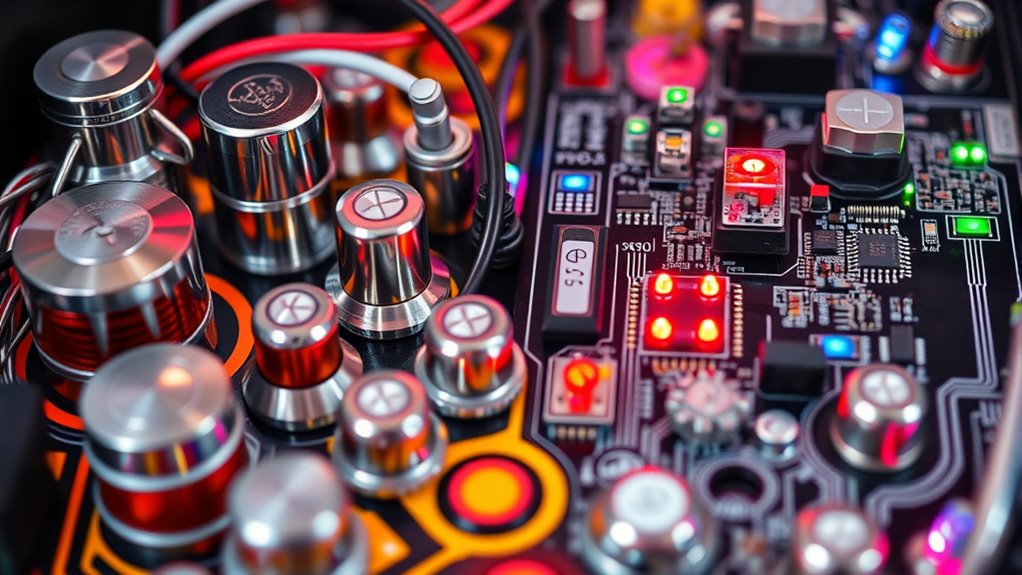
As pinball machines evolved from electro-mechanical designs to solid-state systems, their core components shifted from mechanical parts to electronic circuits. In early EM machines, mechanical complexity was high, with gears, relays, and switches working together to control game functions. These mechanical elements required precise timing and maintenance. With the advent of solid-state technology, electronic integration simplified many of these tasks, replacing mechanical relays with circuit boards and microprocessors. This progression reduced mechanical complexity, making machines more reliable and easier to troubleshoot. Instead of intricate mechanical systems, solid-state pinballs rely on electronic components like transistors, diodes, and integrated circuits, allowing for more advanced and flexible control over gameplay features. This shift marks a significant difference in how core functions are managed in EM versus solid-state pinball machines. Understanding the electronic components used in modern pinball systems helps explain how gameplay capabilities have expanded and become more customizable over time.
Gameplay Mechanics and Player Experience
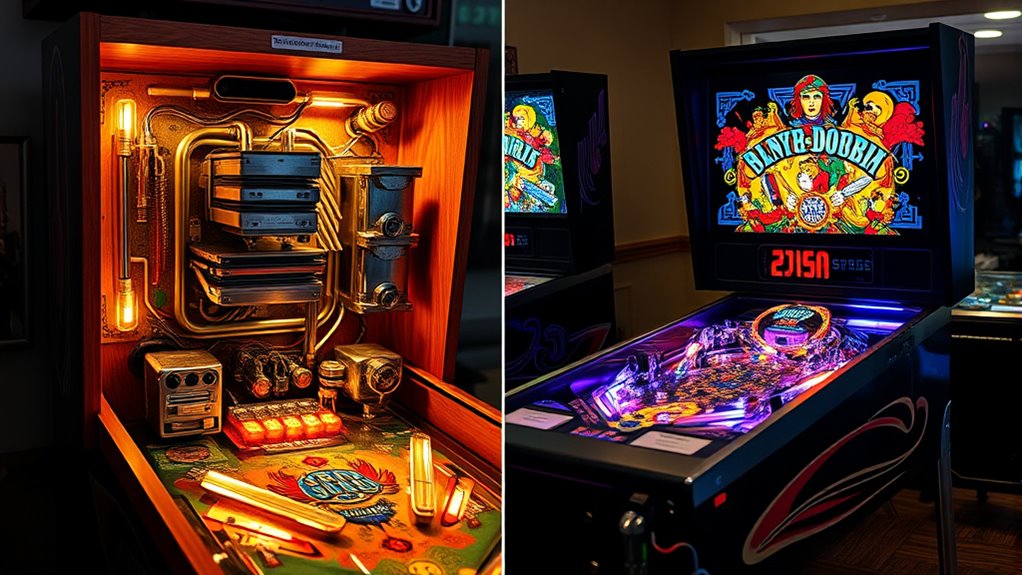
While the core technology behind pinball machines has evolved, the gameplay mechanics and player experience have also transformed markedly. Solid-state machines introduce digital integration, allowing for more complex rules, varied scoring, and dynamic features that keep gameplay fresh and engaging. These advancements enable players to experience intricate missions and multi-ball modes that weren’t possible with traditional electromagnetic setups. Multiplayer capabilities further enhance the experience by letting players compete directly or take turns seamlessly, amplifying social interaction and excitement. EM machines focus on straightforward, mechanical play, offering a tactile feel, but lack the digital enhancements that add depth. Overall, solid-state pinballs provide richer, more versatile gameplay, catering to a broader range of players seeking innovative challenges and shared experiences.
Visual and Sound Design Features
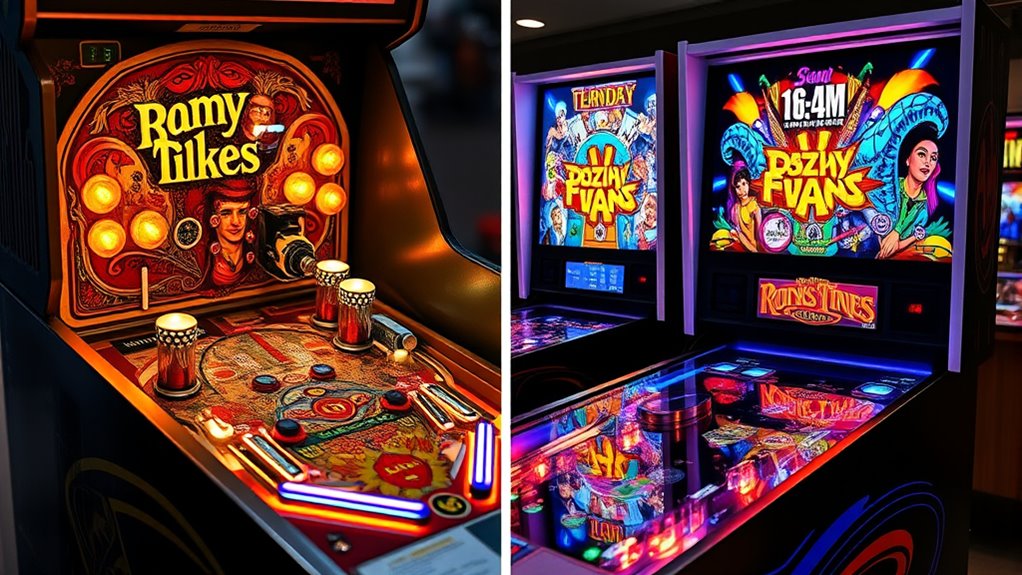
Advancements in visual and sound design have considerably transformed the player’s immersion in pinball machines. With LED lighting, your game becomes vibrant, dynamic, and eye-catching, enhancing visual appeal and highlighting gameplay features. Sound customization allows you to personalize audio effects, making each game more engaging and tailored to your preferences. Solid-state pinball machines often feature brighter, more versatile LED lighting compared to traditional electromagnets, creating exciting visual effects. The sound design in these machines can include layered audio, voiceovers, and customized effects, elevating the overall experience. Here’s a quick comparison:
| Feature | Electromechanical (EM) | Solid-State | Improvements |
|---|---|---|---|
| Lighting | Incandescent bulbs | LED lighting | Brighter, customizable lighting |
| Sound | Simple mechanical sounds | Advanced sound systems | Richer, more personalized audio |
| Visual Effects | Limited, static displays | Dynamic displays, LEDs | More vibrant and engaging |
| Sound Customization | Minimal | Extensive options | Tailored auditory experience |
| Overall Impact | Classic charm | Modern immersion | Enhanced player engagement |
Additionally, technological innovations have made it easier to upgrade and personalize pinball machines, further enhancing visual and sound features.
Maintenance and Repair Requirements
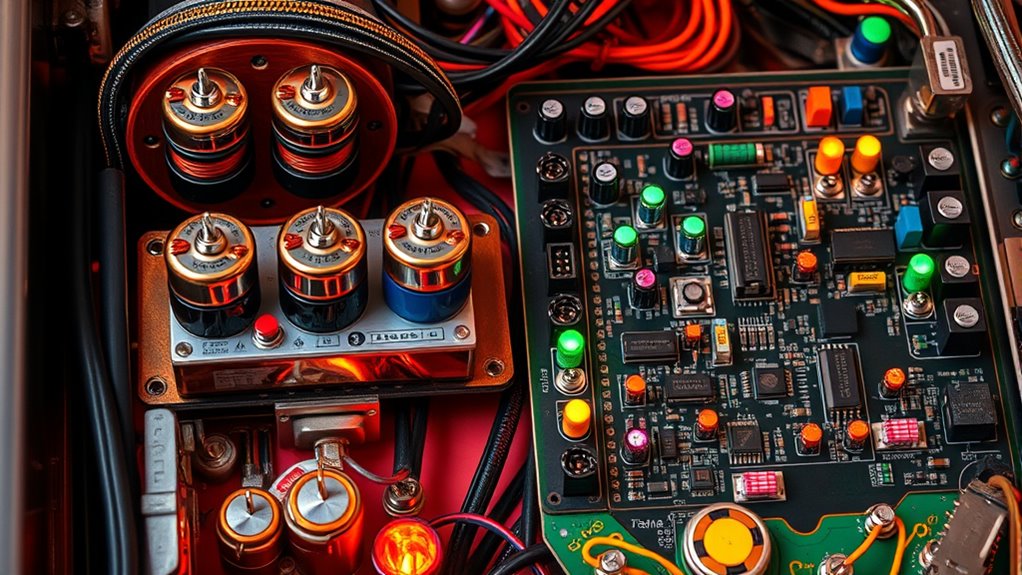
Maintaining and repairing pinball machines requires a solid understanding of their electrical and mechanical components. For EM machines, coil maintenance is essential; you’ll need to regularly check coils for wear, corrosion, or broken wiring, as these can cause scoring or mechanical issues. In solid-state models, circuit board repair becomes more common. You might need to troubleshoot and replace malfunctioning transistors, resistors, or chips. EM machines tend to be simpler but require more manual adjustments, like cleaning contacts and checking wiring connections. Solid-state machines, however, often demand precise circuit diagnostics and sometimes soldering. Additionally, understanding the contrast ratio can help diagnose image quality issues that may arise within the machine’s display or projection components. Regardless of the type, staying vigilant with maintenance prevents costly repairs and keeps your game running smoothly. Regular inspection and timely repairs are key to preserving your pinball machine’s performance.
Cost and Availability in the Market
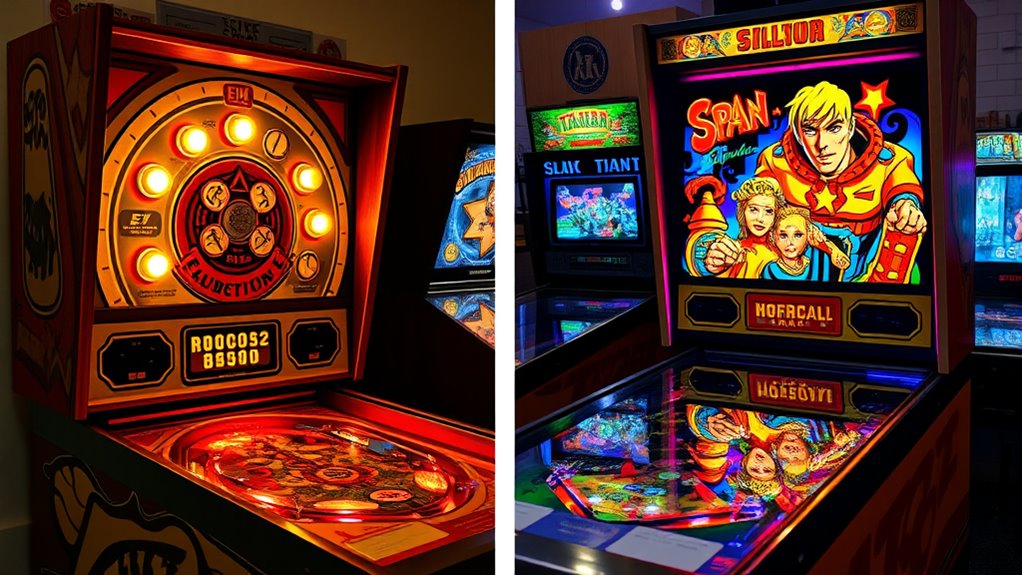
The costs associated with EM and solid-state pinball machines vary considerably, affecting how easily you can access and maintain these games. EM machines are generally more affordable due to their age and lower market saturation, making them easier to find for collectors on a budget. In contrast, solid-state machines tend to be pricier, especially popular models, driven by recent pricing trends and higher demand. Market saturation plays a significant role here: as more EM machines become available, prices tend to stabilize or decline, while rare or sought-after solid-state models can command premium prices. Availability is also impacted by production years; EMs are more plentiful and easier to locate, whereas solid-state games may require more effort or higher costs to acquire, especially vintage or limited-edition models. Additionally, the market demand for these machines influences their resale value and availability on the secondary market.
Popular Models and Collectibility

Some pinball models are more sought after than others, especially iconic vintage titles that collectors prize. Limited edition releases can boost a game’s rarity and value, making them highly desirable. Understanding what makes certain models collectible helps you appreciate their place in pinball history. Additionally, cost variances can influence the desirability and investment potential of different pinball machines.
Iconic Vintage Titles
Vintage pinball titles like “The Addams Family,” “Creature from the Black Lagoon,” and Bally’s Centaur have become highly sought after by collectors, blending nostalgic appeal with enduring gameplay. Their vintage artwork captures the era’s unique style, while classic soundtracks evoke fond memories. These titles are prized for their historic significance and distinctive designs, making them highly collectible. The rarity and condition of these games influence their value, especially when original parts are intact. Condition and rarity significantly impact their worth, with well-preserved examples fetching higher prices. The table below highlights some iconic titles and their features:
| Title | Notable Features |
|---|---|
| The Addams Family | Popular, memorable soundtrack |
| Creature from the Black Lagoon | Unique vintage artwork, gameplay |
| Bally’s Centaur | Classic sound effects, artwork |
| Twilight Zone | Collectible, historical significance |
Limited Edition Releases
Limited edition pinball machines have become highly coveted among collectors, thanks to their exclusive features and limited runs. These machines often showcase custom artwork that sets them apart from standard models, making them highly desirable. Limited editions typically feature unique themes, special decals, and custom cabinet designs that appeal to enthusiasts seeking something rare and eye-catching. Manufacturers release these models in small quantities, which enhances their collectibility and value over time. As a result, limited editions attract players and collectors alike who want a one-of-a-kind gaming experience or a standout piece for their collection. Whether celebrating a milestone or honoring a popular theme, these custom features make limited edition pinball machines a prized addition to any collection. Materials used in these machines often include premium finishes and durable components that contribute to their longevity and appeal.
Rarity and Value
What makes certain pinball models stand out as highly collectible? Rarity factors play a big role, especially when fewer units were produced or if the game had a short production run. These models often attract strong collector interest because their scarcity drives up demand and value. EM pinball machines, especially early or limited editions, tend to be rarer today, making them more desirable for collectors. Solid-state machines, while more common, can still be valuable if they are rare or iconic. The condition, original parts, and authenticity also influence a game’s worth. Overall, the combination of rarity factors and collector interest determines a pinball’s value, making some models sought-after treasures in the pinball collecting world.
Advantages and Drawbacks of Each Type

You’ll notice that EM machines tend to be more durable and easier to maintain, but they lack the advanced features of solid-state models. Solid-state pinballs offer greater electronic flexibility and more modern gameplay options, yet they can be more complex and costly to repair. Understanding these trade-offs helps you decide which type suits your playing style and maintenance preferences. Additionally, wave and wind can influence the overall experience by affecting the machine’s environment and gameplay conditions.
Mechanical Durability and Maintenance
When comparing mechanical durability and maintenance, EM pinball machines generally require more hands-on upkeep due to their complex mechanical components, such as relays and switches, which can wear out over time. These machines demand regular attention to keep ball return systems functioning smoothly and to guarantee that switches and contacts stay clean. The cabinet construction of EM machines is often sturdy, but parts like coil assemblies and mechanical scoring reels need periodic adjustments or replacements. EM pinballs tend to be more durable regarding the physical cabinet, but the intricate mechanical systems can be prone to failure.
- Frequent cleaning of relays and switches
- Monitoring coil and solenoid operation
- Adjustments to ball return mechanisms
- Replacing worn-out contacts
- Ensuring structural stability of cabinet
Electronic Features and Flexibility
Electronic features give pinball machines greater flexibility and modern functionality, making gameplay more dynamic and engaging. With electronic scoring, you get instant feedback and precise point tracking, enhancing the competitive experience. Additionally, these machines often include custom game modes, allowing you to tailor challenges or create themed play options that keep gameplay fresh. You can also program different difficulty levels and multimedia effects, adding variety and excitement. Moreover, Kia Tuning options can enhance the overall performance and aesthetic appeal of your vehicle, providing a personalized touch. However, reliance on electronics means these machines can be more complex to repair and may require software updates. While their advanced features boost gameplay versatility, they can sometimes lead to higher maintenance costs. Overall, electronic features provide a richer, more customizable experience, but you should be mindful of potential technical issues that could arise over time.
Future Trends in Pinball Technology
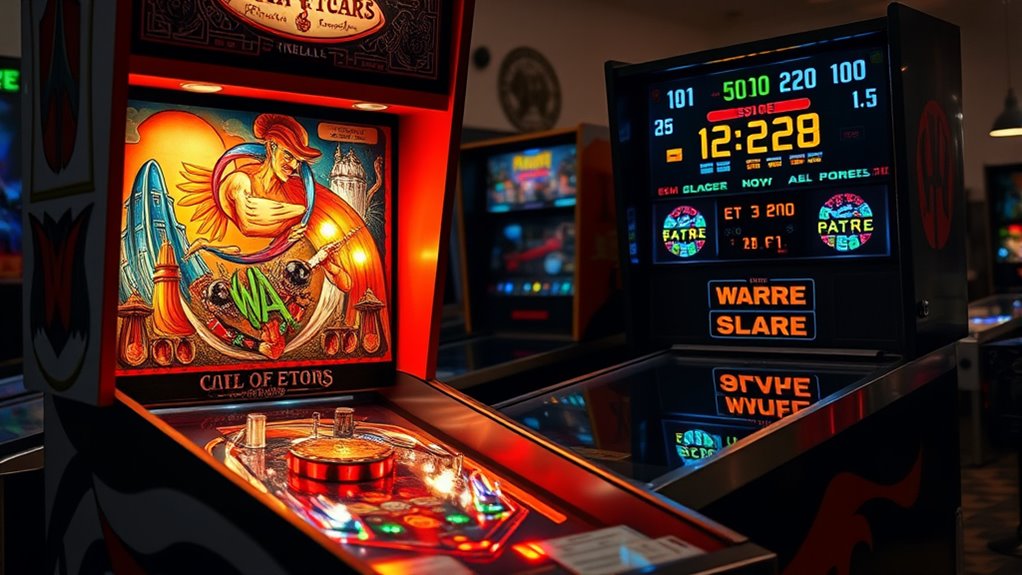
As technology continues to advance, the future of pinball is poised to blend traditional gameplay with innovative features that enhance your experience. Expect more games to incorporate LED lighting, creating vibrant visuals and dynamic effects that respond to gameplay. Wi-Fi connectivity will allow for real-time updates, online leaderboards, and remote diagnostics, making maintenance easier. You might also see augmented reality features that overlay digital elements onto physical playfields, increasing immersion. Touchscreen interfaces could replace manual score displays, offering customizable options. Additionally, smart sensors will monitor game performance, providing insights to players and operators alike. These advancements will make pinball more interactive, engaging, and easier to maintain, ensuring the game evolves while respecting its nostalgic roots.
- LED lighting for visual effects
- Wi-Fi for updates and diagnostics
- Augmented reality integration
- Touchscreen interfaces
- Smart sensors for performance monitoring
Frequently Asked Questions
How Do EM and Solid-State Pinballs Differ in Durability?
When comparing durability, you’ll notice EM pinballs generally handle mechanical wear better over time, thanks to their simpler moving parts. Solid-state machines, however, rely heavily on electronic circuits, which can be more prone to failure and less durable under constant use. You might find EM pinballs more resilient regarding circuit durability, but both types require regular maintenance to keep playing smoothly.
Are There Specific Skill Levels Better Suited for EM or Solid-State Pinball?
You’ll find that skill adaptability varies with your experience level, as solid-state pinball machines often require less maintenance and are easier for beginners to learn on. If you’re more skilled, you might enjoy EM pinball for its classic mechanics and challenge. Ultimately, your comfort with maintenance requirements and how quickly you adapt to different gameplay styles will guide whether EM or solid-state suits you best.
Can EM Pinball Machines Be Converted to Solid-State?
Like turning a classic vinyl record into a digital playlist, converting an EM pinball machine to solid-state isn’t straightforward. You face restoration challenges, as parts differ markedly, and it’s often impractical. Collector preferences also play a role; purists cherish original EMs. While technically possible, most prefer keeping EMs intact to preserve their nostalgic charm. If you’re determined, expect a detailed upgrade process and a focus on authenticity.
What Environmental Factors Affect EM Versus Solid-State Pinball Longevity?
You should know that environmental factors like power fluctuations and humidity effects impact both EM and solid-state pinball machines differently. EM machines are more sensitive to humidity, which can cause corrosion and electrical issues over time. Solid-state machines handle power fluctuations better but still benefit from stable conditions. To guarantee longevity, keep your machines in a controlled environment with consistent humidity and stable power sources.
How Does Power Consumption Compare Between EM and Solid-State Machines?
You’ll find that solid-state pinball machines are more power-efficient than EM models, thanks to advanced electronics that consume less energy. This means lower energy costs over time, making them more economical to run. EM machines tend to use more power due to their mechanical components and older circuitry. So, if you’re looking to save on energy bills, solid-state machines offer better power efficiency and cost savings.
Conclusion
Imagine you’re stepping into a grand arcade, where vintage EM pinballs glow softly like lanterns guiding your way, while sleek solid-state machines pulse with neon energy. Both invite you on a journey—one nostalgic and tactile, the other modern and vibrant. Embrace the dance between tradition and innovation, knowing each offers a unique thrill. Whether you chase history or future, the world of pinball welcomes you to play, explore, and keep the magic alive.


